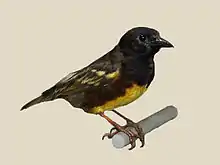Weyns's weaver
| Weyns's weaver | |
|---|---|
 | |
| Specimen at Nairobi National Museum Eyes should be yellow. | |
| Scientific classification | |
| Domain: | Eukaryota |
| Kingdom: | Animalia |
| Phylum: | Chordata |
| Clade: | Dinosauria |
| Class: | Aves |
| Order: | Passeriformes |
| Family: | Ploceidae |
| Genus: | Ploceus |
| Species: | P. weynsi |
| Binomial name | |
| Ploceus weynsi (Dubois, 1900) | |
Taxonomy
The Weyns's Weaver belongs to the Animalia Kingdom, the Chordata Phylum, the Aves Class, the Passeriformes Order, the Ploceidae Family, and the Ploceus Genus.[2] The species name for the Weyns's Weaver is the Ploceus weysni. This bird is monotypic, meaning that it does not include a subspecies or a smaller, infraspecific taxa. [3]
Field Identification
The Weyns's Weaver differs from males to females in a number of physical characteristics. On average, the males are heavier than the females, weighing 24-36g, while the females weigh 23-34g. Made up of black, olive-green, yellow, and brown, the males are much darker in appearance than the females, who are much more yellow. The males have a black head and back, with a yellow and orange belly. Younger birds are mostly yellow with hints of black, closely resembling the female birds. [3]
Distribution & Habitat
The Weyns's Weaver is found in a number of countries throughout the continent of Africa. These countries include the Northeast Democratic Republic of the Congo, South Uganda, Northwest Tanzania, and even Kenya.[3] This entire range where this bird lives is a conservation area. This bird can most likely be found in terrestrial areas, as well as forests with tall trees and wetlands. This Weaver is attracted to inland bodies of water, such as freshwater and lakes. [2]
Diet & Foraging
Fruits, including wild figs, make up the majority of the diet for the Weyns's Weaver. Their diet is seen mainly throughout the forest canopy. This bird frequently forages for food in pairs or flocks, doing most everything in groups. The feeding flocks are most often made up of 20 individuals, however, on occasion, they can flock in groups of up to 200 or more. [3]
Movement
In terms of movement, the Weyns's Weaver appears to wander erratically.[3] This bird is not a migrant species.[2] In the months of June through September, it is absent from talk shore areas. This implies that their movements differ depending on the seasons. [3]
Breeding
The adults in the Democratic Republic of the Congo are observed to have enlarged gonads in the months of April through June. In areas like Uganda, these changes occur during the months of June and July, and the offspring are found in November. Following the breeding period, the Weyns's Weaver is moulted in the months of September to November. [3]
Songs & Vocal Behavior
The vocal behavior of the Weyns's Weaver can be described as a very high-pitched sizzling sound.[3] Their songs are filled with many chirps and longer squeaking sounds. They are relatively quiet, unless they are joined by others to make a group. [4]
Conservation Status
In terms of conservation status, the Weyns's Weaver is considered to be a species of least concern. [2] This species can be encountered in reasonable numbers, and is not globally threatened, for they have a stable population trend. This bird is locally common, but its presence is often unpredictable.[3] Their population is predicted to be stable for at least their generational length of 4 years in the absence of any declines of substantial threats.[2]
References
- BirdLife International (2016). "Ploceus weynsi". IUCN Red List of Threatened Species. 2016: e.T22718941A94603078. doi:10.2305/IUCN.UK.2016-3.RLTS.T22718941A94603078.en. Retrieved 11 November 2021.
- BirdLife International (1 October 2016). ""The IUCN Red List of Threatened Species"". IUCN Red List of Threatened Species. Retrieved 18 October 2023.
- Craig, Adrian J. F. (2020). "Weyns's Weaver (Ploceus weynsi), version 1.0". Birds of the World. doi:10.2173/bow.weywea1.01species_shared.bow.project_name. ISSN 2771-3105.
- "Weyns's Weaver (Ploceus Weynsi): Xeno-Canto". Xeno-Canto. Retrieved 18 October 2023.
